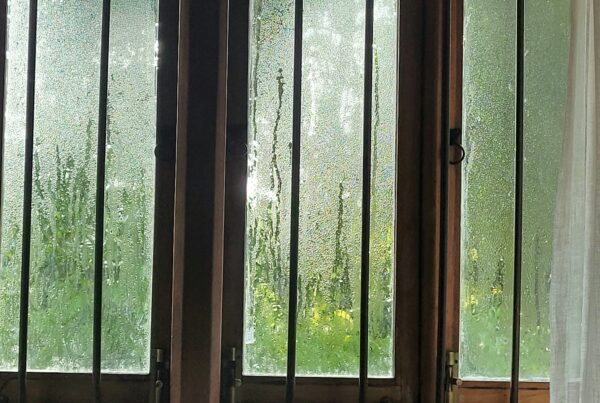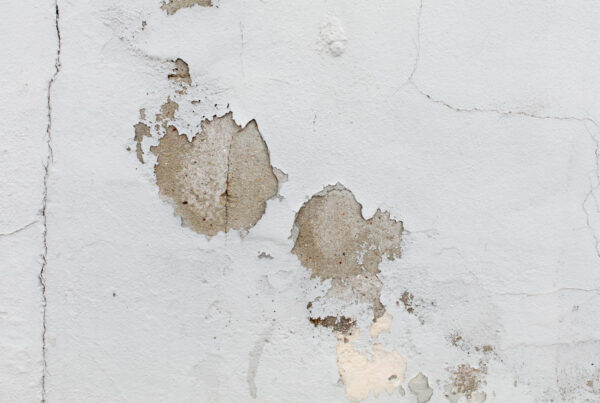Penetrating dampness affects many UK properties, causing structural damage and unhealthy living conditions when external moisture finds its way through building defects into a home. Recognising penetrating damp signs early helps to seek professional treatment before incurring costly damage.
In this article, you will uncover the key warning signs of penetrating moisture, learn where dampness commonly appears, understand what causes water ingress, and explore effective treatment solutions.
What Is Penetrating Dampness and How Does It Develop?
Penetrating dampness occurs when external moisture penetrates a property’s walls, roof, or other structural elements due to building defects or deterioration. Unlike rising damp, which travels upward from the ground, penetrating moisture moves horizontally through walls from external sources.
This dampness usually develops during heavy rainfall, when driving rain forces water through compromised building materials or structural weaknesses. The moisture then travels through wall cavities, appearing on internal surfaces, creating damp patches and structural damage.
Older buildings with traditional construction face higher risks due to deteriorating materials and construction techniques that may not meet modern waterproofing standards.
What Are the Key Visual Signs of Penetrating Damp?
Identifying penetrating damp signs helps distinguish this moisture problem from other types of dampness. Primary visual signs include:
- Damp patches on walls – Dark, discoloured areas that appear on internal walls, typically after heavy rainfall or driving rain
- Water stains and tide marks – Brown or yellow staining on walls and ceilings, indicating repeated moisture penetration cycles
- Peeling paint and wallpaper – Decorative finishes that bubble, peel, or fail due to moisture penetration behind surfaces
- Plaster deterioration – Soft, crumbling, or blown plaster areas where moisture has compromised material integrity
- Mould growth patterns – Black mould or fungal growth appearing on affected walls, especially in corners or around windows
The pattern and location of damp patches indicate the source of water ingress. Dampness near windows, doors, or roof areas suggests defects in these weatherproofing elements.
Where Does Penetrating Dampness Commonly Occur?
These are more common penetrating damp locations:
- Around windows and doors – Faulty seals, damaged frames, or poor installation allow water penetration into the surrounding wall areas
- Roof and chimney areas – Missing tiles, damaged flashing, or defective pointing create entry points for rainwater penetration
- External wall faces – South and west-facing walls experience the most weather exposure and show penetrating damp more frequently
- Bay windows and projections – Architectural features extending from the main building face additional weather exposure risks
- Ground level areas – Raised ground levels, defective drainage, or damaged renders can cause water penetration at ground floor level. It’s also worth investing in basement waterproofing services if needed.
Properties with cavity wall construction can experience penetrating dampness when wall ties fail, cavity insulation becomes saturated, or external renders develop cracks, allowing moisture to penetrate.
What Causes Penetrating Dampness in Buildings?
The core primary causes of penetrating damp include:
- Roof defects and damage – Missing or damaged tiles, failed flashing, blocked gutters, or deteriorated pointing allow rainwater to penetrate roof structures.
- External wall problems – Cracked renders, failed pointing, damaged brickwork, or deteriorated external coatings compromise weather resistance.
- Window and door issues – Poor installation, damaged seals, faulty drainage, or frame deterioration create water ingress routes.
- Cavity wall failures – Saturated insulation, failed wall ties, or bridged cavities allow moisture to cross from external to internal wall surfaces.
- Raised ground levels – Soil, paving, or landscaping that bridges damp proof courses or creates moisture retention against external walls.
How Can You Distinguish Penetrating Damp from Other Moisture Problems?
Accurate diagnosis of penetrating dampness helps to find suitable treatment and prevents ineffective solutions that address symptoms rather than the causes.
Penetrating damp often appears on external walls and correlates with weather conditions, appearing or worsening during rainy periods. The dampness shows irregular patterns that follow the path of water ingress through building defects.
Condensation dampness affects multiple areas throughout the property and correlates with internal activities like cooking or heating rather than external weather. Rising damp creates horizontal moisture bands, usually up to 1.5 metres high, on ground-floor walls, accompanied by salt deposits, and doesn’t correlate with weather conditions.
Professional assessment using electronic meters and visual inspection helps distinguish between different dampness types and identifies the treatment approach required for your property.
When Should You Get Professional Help for Penetrating Damp?
Professional assessment is recommended when penetrating damp signs appear repeatedly, affect multiple areas, or show structural damage indicators.
Contact specialists immediately if you notice the sudden appearance of large, damp patches, rapid deterioration of internal finishes, or signs of structural movement associated with moisture penetration.
Properties showing multiple penetrating damp signs benefit from a comprehensive assessment to identify all water ingress routes and underlying causes. DIY repairs address only visible symptoms rather than root causes, leading to recurring problems and escalating damage.
Our penetrating damp services provide detailed assessments that identify defects and recommend targeted treatments. Our proven expertise addresses immediate moisture problems and underlying building maintenance issues.
How Can You Prevent Penetrating Dampness?
Effective penetrating damp prevention focuses on keeping your property’s weather resistance strong and addressing building defects before they allow moisture ingress.
Annual roof inspections help identify missing tiles, damaged flashing, or blocked gutters before they cause internal moisture penetration. Clear gutters and downpipes regularly to prevent overflow that can saturate external walls.
Additionally, keep the external wall’s weather resistance strong through prompt pointing repairs, render maintenance, and addressing cracks that could allow water penetration. Monitor external wall conditions after severe weather and address damage promptly.
You should also check window and door seals annually and replace deteriorated weatherstripping that could allow moisture penetration. Ensure adequate drainage around building perimeters to prevent water accumulation against external walls.
Resolve Penetrating Dampness with Expert Solutions From Refresh
Penetrating damp signs indicate building defects that threaten a property’s structural integrity and internal environment. The experienced specialists at Refresh Property Services and Consultants understand how water ingress affects London properties and provide comprehensive diagnostic and treatment services.
Our assessment identifies specific defects causing moisture ingress and recommends targeted repairs that address root causes rather than symptoms. We deliver lasting solutions that protect your property investment from roof repairs to external wall treatments. Contact us today for professional penetrating damp assessment and expert treatment solutions.



